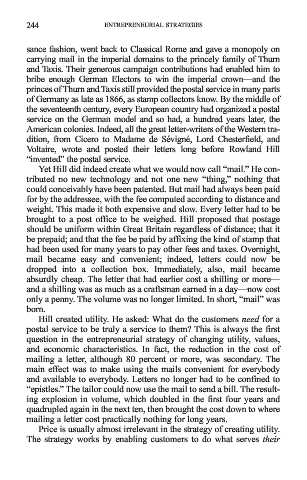Page 251 - ENTREPRENEURSHIP Innovation and entrepreneurship
P. 251
53231_Innovation and Entrepreneurship.qxd 11/8/2002 10:50 AM Page 244
244 ENTREPRENEURIAL STRATEGIES
sance fashion, went back to Classical Rome and gave a monopoly on
carrying mail in the imperial domains to the princely family of Thurn
and Taxis. Their generous campaign contributions had enabled him to
bribe enough German Electors to win the imperial crown—and the
princes of Thurn and Taxis still provided the postal service in many parts
of Germany as late as 1866, as stamp collectors know. By the middle of
the seventeenth century, every European country had organized a postal
service on the German model and so had, a hundred years later, the
American colonies. Indeed, all the great letter-writers of the Western tra-
dition, from Cicero to Madame de Sévigné, Lord Chesterfield, and
Voltaire, wrote and posted their letters long before Rowland Hill
“invented” the postal service.
Yet Hill did indeed create what we would now call “mail.” He con-
tributed no new technology and not one new “thing,” nothing that
could conceivably have been patented. But mail had always been paid
for by the addressee, with the fee computed according to distance and
weight. This made it both expensive and slow. Every letter had to be
brought to a post office to be weighed. Hill proposed that postage
should be uniform within Great Britain regardless of distance; that it
be prepaid; and that the fee be paid by affixing the kind of stamp that
had been used for many years to pay other fees and taxes. Overnight,
mail became easy and convenient; indeed, letters could now be
dropped into a collection box. Immediately, also, mail became
absurdly cheap. The letter that had earlier cost a shilling or more—
and a shilling was as much as a craftsman earned in a day—now cost
only a penny. The volume was no longer limited. In short, “mail” was
born.
Hill created utility. He asked: What do the customers need for a
postal service to be truly a service to them? This is always the first
question in the entrepreneurial strategy of changing utility, values,
and economic characteristics. In fact, the reduction in the cost of
mailing a letter, although 80 percent or more, was secondary. The
main effect was to make using the mails convenient for everybody
and available to everybody. Letters no longer had to be confined to
“epistles.” The tailor could now use the mail to send a bill. The result-
ing explosion in volume, which doubled in the first four years and
quadrupled again in the next ten, then brought the cost down to where
mailing a letter cost practically nothing for long years.
Price is usually almost irrelevant in the strategy of creating utility.
The strategy works by enabling customers to do what serves their

